by Matteo Calla // Feb. 3, 2023
This article is part of our feature topic ’FAMILY.’
In ‘GG,’ Ad Minoliti’s latest show at Peres Projects in Berlin, the white cube has been domesticated. Stepping into the gallery space on Karl-Marx-Allee feels less like entering a contemporary art venue and more like an adolescent’s living room. On the walls and floors, the usual set of individual works for individual consumption has been swapped with decor and furniture: paintings extending seamlessly into wall paint and spilling onto carpets dotted with bean bag chairs and stools shaped like cartoon cats, all rendered in bold geometry and primary colors.
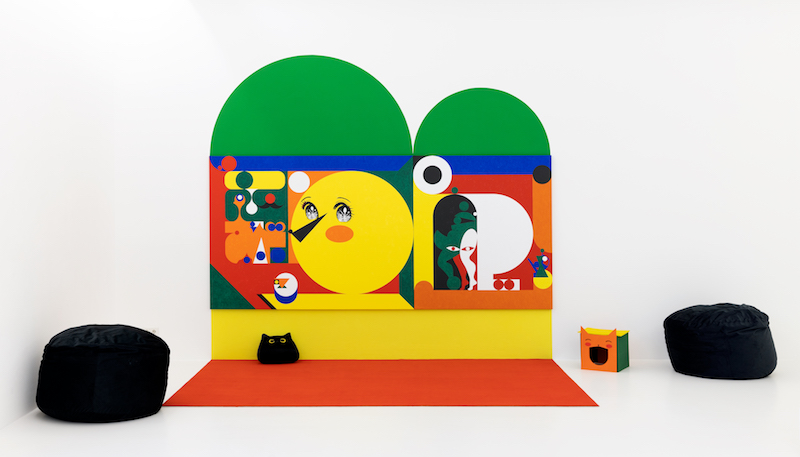
Ad Minoliti: ‘GG,’ 2023 // Photo by Timo Ohler, courtesy of Peres Projects
But what kind of domicile is this? What sort of family lives here? Clues could be found on the walls themselves. Like many adolescent living spaces, they are full of characters, full of life. But these are not the sort of characters found in Disney—the anthropomorphic animals and objects of ‘Toy Story’ or ‘The Lion King’—brought to life by being granted human form and behavior. Rather, through very subtle gestures blending the abstract with the figurative—geometrical shapes given a cat’s eye here, curving into the suggestion of a leg there, blossoming into a flower—animal and human, plant and object are enlivened on their own terms.
The world presented in ‘GG’ isn’t anthropomorphic so much as animistic, a kind of geometric animism. In our conversation, Minoliti described the difference by presenting a hand puppet they made, a sort of green triangle. “It’s not like the hand gives life to the object. It’s that the object is queering the body. To think it in the reverse way of the anthropomorphic. There is no border between hand and puppet.” The human is not the privileged domain of conscious life. Rather, such life pulses through everything, in excess even of biological form.
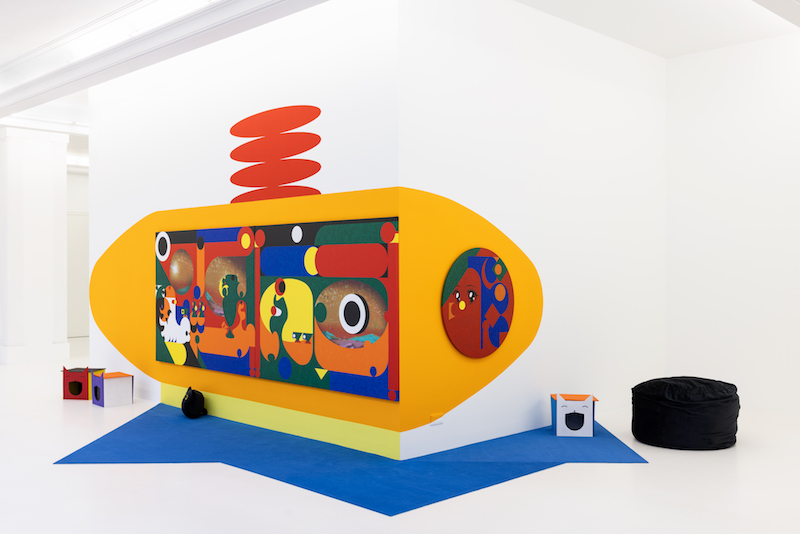
Ad Minoliti: ‘GG,’ 2023 // Photo by Timo Ohler, courtesy of Peres Projects
‘GG’ suggests a notion of community or kinship extending beyond the traditional family, beyond the world of humans and even the world of animals and plants, to include the object world itself. For Minoliti, such thinking is fundamentally non-binary, an antidote to an anthropocentric worldview dividing sentient human subjects from non-sentient beings and inanimate objects. It is a radically inclusive idea of community, crucial in countering a dominant logic of extractivism and exploitation based on privileged binaries: “The division of culture/nature, men/women, it’s a binary vision of the world and very capitalist in the sense that we also treat plants, soil, the ecosystem and the Earth like objects. It’s a mistreatment. Nature is nonbinary.”
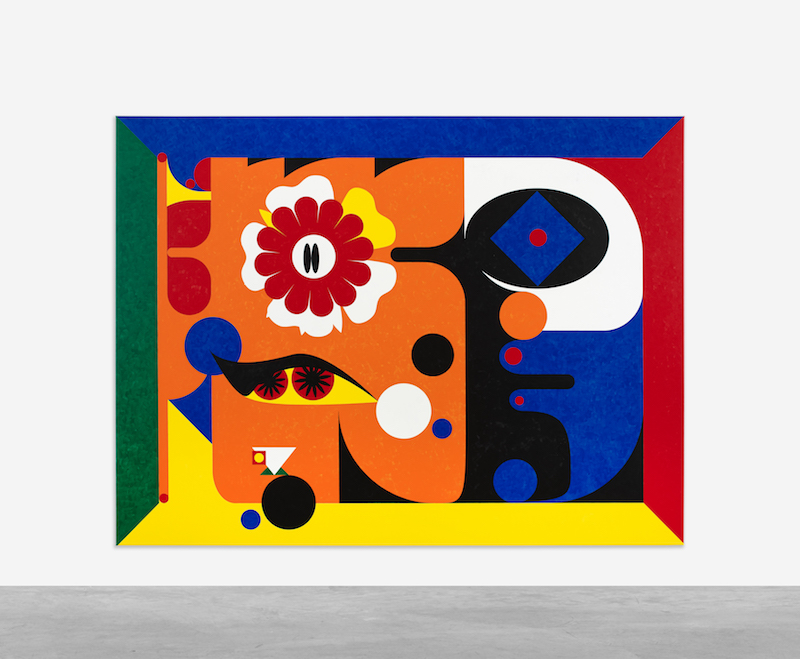
Ad Minoliti: ‘SPACE CAT CAFE SERIES,’ 2022, acrylic on canvas, 150 x 200 cm // Courtesy of Peres Projects
To be fair, there is a series of paintings in ‘GG’ that adheres closer to the anthropomorphic. These are round, acrylic-on-canvas works with apparently human names (Marvin, Marcus and Tuiti) that also contain elements that make them more closely resemble human faces: two eyes and forms suggesting noses, mouths, a mustache and maybe a hat. In a possible nod to humanity’s sense of its own separateness, two of these, Marcus and Tuiti, appear isolated on white wall space, separate from the continuous formal ecosystem that constitutes much of the rest of the installation. But in Minoliti’s radically inclusive world, perhaps even the human exceptionalist has its place.
For Minoliti, queer and trans youth are in particular need of the kind of inclusive, non-binary space presented in ‘GG.’ Its joyful universe valorizes a plurality of living forms extending far beyond the narrow range of gendered, heterosexual humans privileged in wider culture. In this sense, the space created in ‘GG’ is queer, but without limiting itself to traditionally queer iconography (queer icons are also, of course, included in ‘GG.’ Minoliti plans a show in the space involving drag performers).
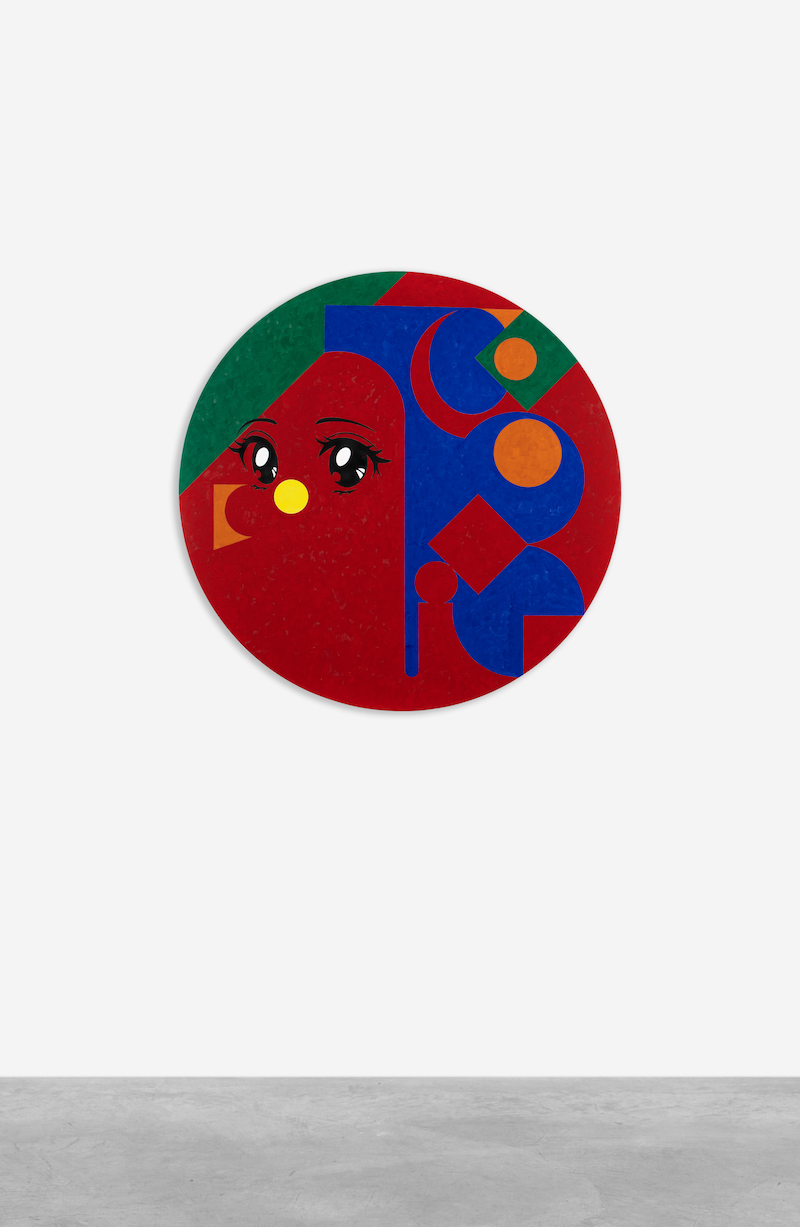
Ad Minoliti: ‘MARVIN,’ 2022, acrylic on canvas, 100 x 100 cm // Courtesy of Peres Projects
In another sense, the geometric animism displayed in ‘GG’ empowers queer and trans youth by suggesting the ability to change one’s form, to extend and alter it. Returning to Minoliti’s green triangle hand puppet, the artist concludes: “How to lose a shape that is projected on you? That the institution, when you were born, said: ‘It’s a boy.’ How to lose that shape?” By imbuing geometry with life, Minoliti opens up the possibility of a limitless modification of the human form, beyond the biologically given. “I found, with geometry, a tool for queering spaces,” says Minoliti. “That’s the formula of my work.”
‘GG’ can be read alongside ‘Furry Tales’—Minoliti’s show last winter at La Casa Encendida in Madrid—as a part of a larger project seeking to conceive of more equitable spaces for queer and trans kids. Such spaces, they suggest, are urgently needed today, in an era of non-consensual surgeries for intersex babies and right-wing scaremongering over drag performers reading to elementary school kids. Whereas the Right seeks to control young people, extending, with the anti-abortion movement, to a person’s right to choose, Minoliti suggests that minors are better protected if they are granted autonomy, empowered to make their own decisions in environments that nurture empathy, curiosity and knowledge.
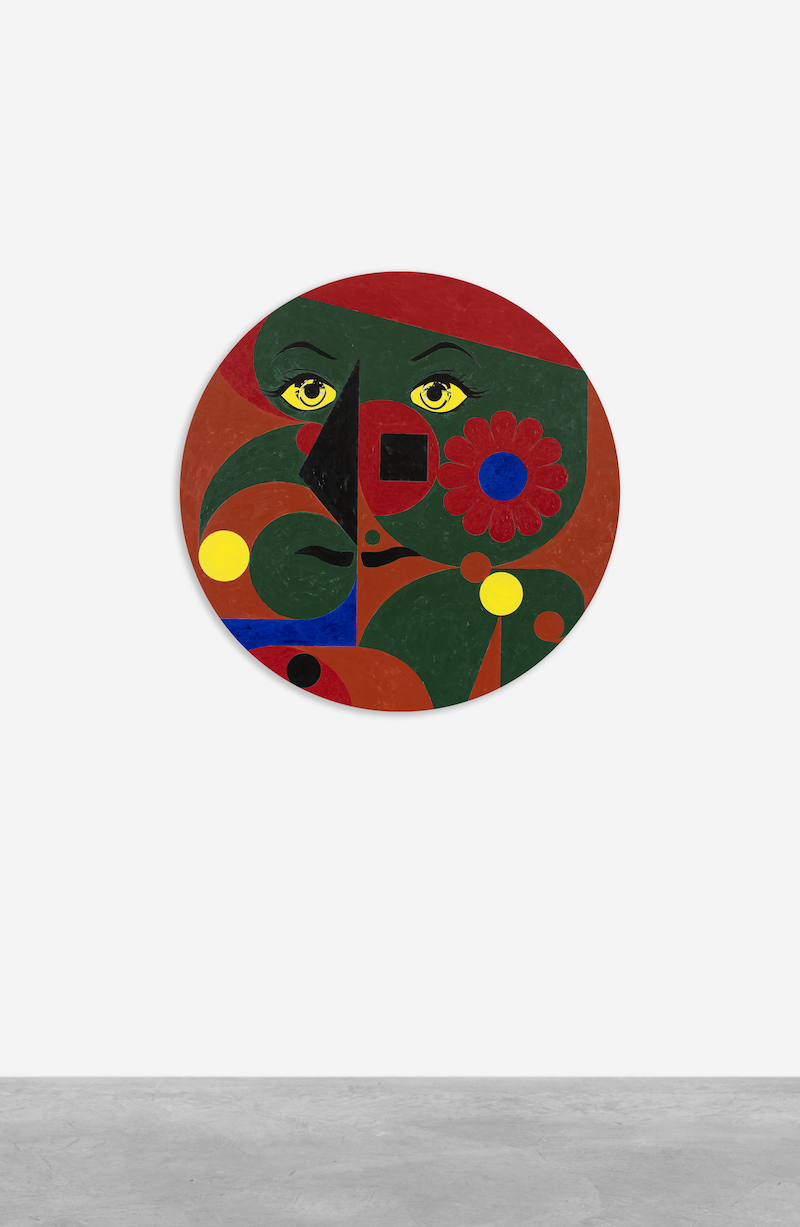
Ad Minoliti: ‘MARCUS,’ 2023, acrylic on canvas, 100 x 100 cm // Courtesy of Peres Projects
‘GG’ and ‘Furry Tales’ both attempt to produce this kind of environment: full of warm and tender characters in a multitude of forms, where children or youth can gather together and play, where possibilities are endless and nothing is coerced. But whereas ‘Furry Tales’ was specifically addressed to children (or, as Minoliti says, the children in us) through a queering of the ‘Little Red Riding Hood’ story, ‘GG’ is envisioned as a space for adolescents. Minoliti suggests that kids in this age group have different needs, chief among these the need for space at all, where they can socialize on their own with friends.
For queer and trans youth, this need for space is urgent.”Trans people do not have free access to spaces, because we might be in danger,” says Minoliti. “Bathrooms are the most explicit example. But I think it happens everywhere. It doesn’t matter if it’s public or private space. You might get kicked out from your own house, when you’re a teenager.” There’s a need for a safe space, where queer and trans youth are free from the threat of physical harm and their identities are acknowledged.
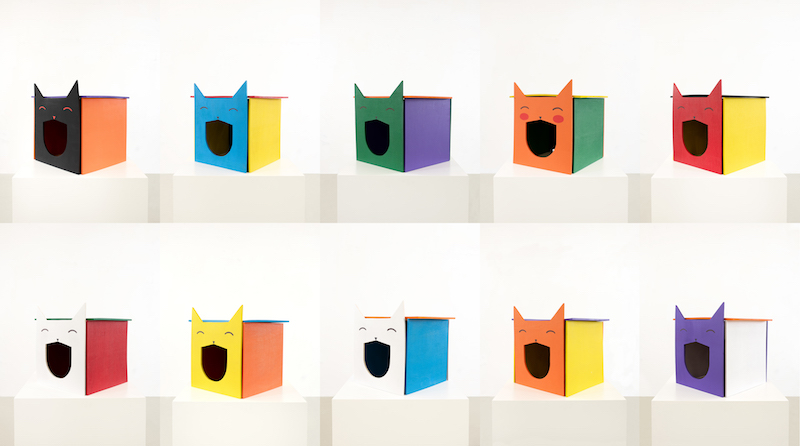
Ad Minoliti: ‘Case study cat houses,’ 2016, acrylic on wood, 42 x 33 x 41 cm // Courtesy of Peres Projects
‘GG’ seeks to be this kind of space, a heterotopia for queer and trans youth. Its model is the cat cafe where cats are meant for adoption (‘GG’ stands for galáctica gatoteca, roughly, “space cat cafe”), a kind of positive alternative to the Starbucks or McDonalds in which Minoliti claims youth often unfortunately find themselves, in which community can be fostered between beings of all kinds. On February 4th, there will also be live music, drag and poetry performances in the gallery space, transforming it into an actual community space for youth.
Of course, as Minoliti acknowledges, the performance, and the space itself, are short-lived. But that isn’t really the point. Rather, ‘GG’ serves a critical function, shedding light on what is lacking in the world and what is possible in another. “It’s a metaphor, a fantasy. That’s what my shows are, fantasies,” says Minoliti. “It’s not escapism. It’s about rethinking, with fantasies, all the problems we find. I want to use it for the things I see as being very urgent, like protecting trans kids. Now I’m focussing on all the fantasies—the aesthetics and storytelling—that build childhood.”
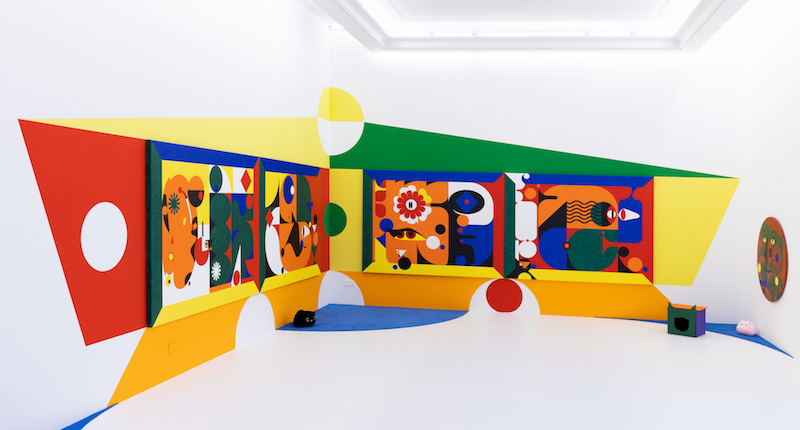
Ad Minoliti: ‘GG,’ 2023 // Photo by Timo Ohler, courtesy of Peres Projects
Exhibition Info
Peres Projects
Ad Minoliti: ‘GG’
Exhibition: Jan. 13-Feb. 10, 2023
Performance: Feb. 4, 2023; 4-6pm
peresprojects.com
Karl-Marx-Allee 82, 10243 Berlin, click here for map























